Interstate 15
Interstate 15 (I-15) is a major Interstate Highway in the western United States, running through Southern California and the Intermountain West. I-15 begins near the Mexico–US border in San Diego County and stretches north to Alberta, Canada, passing through the states of California, Nevada, Arizona, Utah, Idaho, and Montana. The Interstate serves the cities of San Diego, Las Vegas, Salt Lake City, Idaho Falls, and Great Falls. It also passes close to the urban areas of Orange County and Los Angeles County, California. The stretches of I-15 in Idaho, Utah, and Arizona have been designated as the "Veterans Memorial Highway".[2] The southern end is at a junction with I-8 and State Route 15 (SR 15) in San Diego, and the northern end is at a connection with Alberta Highway 4 at the Sweetgrass–Coutts Border Crossing.
| |
|---|---|
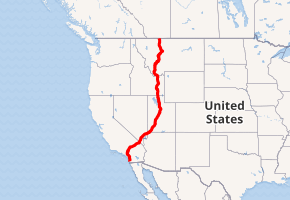
| |
| Route information | |
| Length | 1,433.52 mi[1] (2,307.03 km) |
| Existed | 1957–present |
| Major junctions | |
| South end | |
| |
| North end | |
| Location | |
| States | California, Nevada, Arizona, Utah, Idaho, Montana |
| Highway system | |
I-15 was built to connect the Inland Empire with San Diego in California, facilitate tourism access to Las Vegas, provide access to the Arizona Strip, interconnect all of the metropolitan statistical areas in Utah except for Logan, and provide freeway bypasses for Pocatello, Idaho Falls, and Great Falls. Since its creation, I-15 has served as a long-haul route for North American commerce. It is now officially chartered for this purpose: from the junction of I-515 in Las Vegas to the Canadian border, I-15 forms part of the CANAMEX Corridor, a High Priority Corridor, as a result of the North American Free Trade Agreement.[3] Since the construction of I-15, California, Nevada, and Utah have consistently ranked in the fastest-growing areas of the United States. As a result, the route of I-15 has substantially increased in population and commuter traffic.
Route description
| mi[1] | km | |
|---|---|---|
| CA | 287.26 | 462.30 |
| NV | 123.77 | 199.19 |
| AZ | 29.39 | 47.30 |
| UT | 401.07 | 645.46 |
| ID | 196.00 | 315.43 |
| MT | 396.03 | 637.35 |
| Total | 1,433.52 | 2,307.03 |
This highway's southern terminus is in San Diego, California, at Interstate 8, although via California State Route 15, a southern extension of the freeway, the route connects to Interstate 5 just north of the Mexico–US border.[4] The northern terminus is in Sweet Grass, Montana, at the Canada–US border, where it becomes Alberta Highway 4. It is 1,433 miles (2,306 km) long from San Diego to Sweet Grass.
California
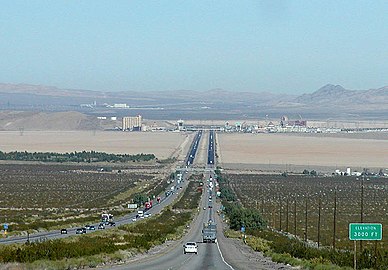
North of its junction with State Route 91 in Corona, the route roughly follows the former routes of State Route 31. North of Devore, the highway follows the approximate alignment of historic U.S. Highway 66 along with U.S. Highway 91 and U.S. Highway 395. U.S. 395 breaks away at Hesperia and the route continues on a direct path to Barstow 35 miles (56 km) to the north. Meanwhile, the old alignments of U.S. 91 and U.S. 66 follow the Mojave River from Victorville to Barstow along the National Trails Highway. At that point, I-15 follows the old route of U.S. 91 exclusively as U.S. 66 turned east toward Needles. For many parts of the highway, high-voltage power lines, such as Path 46 and Path 27, almost all originating from the Hoover Dam, follow the freeway. Many of these link distant power stations to the Los Angeles metropolitan area.
The southern starting point of Interstate 15 was in 1957 planned to be in San Bernardino, at the interchange with the San Bernardino Freeway (then US 70/99, now I-10). This was logical as I-15 was following the old alignment of the historic Route 66 which passed through San Bernardino. The segment was completed accordingly.
In 1964, legislation was later passed to extend the interstate to San Diego. Instead of extending the existing freeway from the I-10 interchange south, however, the California Department of Transportation drew a new segment in Devore that "branched" off of the original alignment and bypassed San Bernardino altogether. This segment's alignment is generally northeast to southwest for about 13 miles (21 km). Then, in Rancho Cucamonga, its directional alignment shifts to north–south where it eventually meets with Interstate 10 (about 15 miles (24 km) west of the original interchange in San Bernardino). The segment that had been built from Devore to San Bernardino was retained as an interstate, but was re-numbered as Interstate 215. Note that during the construction of I-15's present alignment, and for some time afterwards, I-215 was numbered as I-15E, and its actual mileage would begin at Interstate 10. I-15 runs for a total of 287 miles (462 km) in California.
Nevada
.jpg)
Interstate 15 begins in Primm and continues through Las Vegas along the Las Vegas Strip corridor. Then the interstate crosses the border with Arizona in Mesquite. The interstate in Nevada runs entirely in Clark County, for a distance of 123.8 miles (199 km).
Arizona
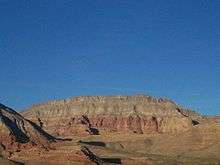
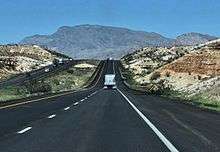
I-15 passes through the northwestern corner of Arizona with a total length of 29.4 miles (47 km).[5] The stretch is separated from the rest of the state and has one major exit, at Beaver Dam/Littlefield, Arizona. It includes a spectacular section where the road twists between the narrow walls of the Virgin River Gorge.
Utah
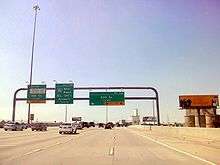
I-15 continues through Utah for 401 miles (645 km). It is the main north–south connection for the state. The highway approximately follows the old alignment of U.S. Highway 91 from St. George to Brigham City. The highway passes through the fast-growing Utah's Dixie region in the southwestern part of the state, which includes St. George, Cedar City, and eventually most of the major cities and suburbs along the Wasatch Front, including Provo, Orem, Sandy, Salt Lake City, Layton, and Ogden. Near Cove Fort, Interstate 70 begins its journey eastward across the country. The interstate merges with I-80 for about 3 miles (5 km) from South Salt Lake to just west of Downtown Salt Lake City and also merges with Interstate 84 from Ogden to Tremonton. Along nearly its entire length through the state, I-15 winds its way along the western edge of a nearly continuous range of mountains (the Wasatch Range in the northern half of the state). The only exceptions are north of Cove Fort and when it passes between Cedar City and St. George, known as the Black Ridge, a transition zone of drastic change in elevation and climate, an area where the eastern Great Basin, Colorado Plateau and Mojave Desert converge.
Idaho
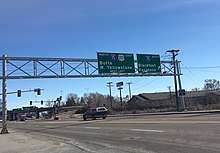
I-15 passes through Idaho for 196 miles (315 km). Interstate 15 crosses the Utah state line in Oneida County. The highway runs through Pocatello, Blackfoot, and Idaho Falls, intersecting with Interstate 86. The last county in Idaho that Interstate 15 passes through is Clark County. Finally, the interstate reaches the Montana state line at Monida Pass.
Montana
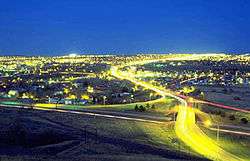
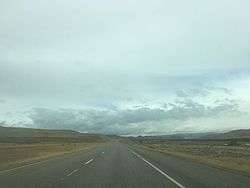
Interstate 15 continues onward through 396 miles (637 km) of Montana through the cities of Butte, Helena and Great Falls, intersecting with Interstate 90, Interstate 115 and Interstate 315. At Sweet Grass, I-15 terminates upon crossing the Canadian border into the province of Alberta; however, I-15 signage is present on Alberta Highway 4 southbound from Lethbridge to the Canadian border.
History
Interstate 15 was constructed along the route of U.S. Route 91. Once Interstate 15 was relatively intact, U.S. 91 was decommissioned, except for one part in Northern Utah/Southern Idaho where Interstate 15 instead followed the route of former U.S. Route 191.
Interstate 15 originally had two suffixed routes. In California, Interstate 15 had an eastern branch bypassing San Bernardino, which was designated Interstate 15E. I-15E was renumbered and is now Interstate 215. Present day routing of Interstate 15 in California was originally given "I-15W" as its title while it was under construction (the original asphalt portions from Temescal Canyon to Ontario Avenue were dubbed I-15W on maps until 1974), but was never officially signed as such.[6] In Idaho, I-15 had a western branch near Pocatello that connected I-15 and I-84 (then I-80N). This highway was designated Interstate 15W. It is now the western I-86.[7]
Growth along route
Since the construction of Interstate 15, California, Nevada, and Utah have consistently ranked in the fastest-growing areas of the United States. As a result, the route of I-15 has substantially increased in population and commuter traffic has increased the traffic burden on the freeway. Current population estimates are that more than 75 percent of the population of Utah,[8] 19 percent of the population of California, and more than 70 percent of the population of Nevada live in counties where Interstate 15 is the primary Interstate Highway.
Similarly, in California, Interstate 15 is seeing more commuter traffic due to the growth of the Mojave Desert communities of Hesperia, Victorville and Barstow. In Utah, I-15 has been near-constantly upgraded in the Wasatch Front, and future plans released by the Utah Department of Transportation (UDOT) indicate that this will continue in the north and the far south of the state as well, due to the extremely rapid growth of Washington County and surrounding areas. In like manner, Las Vegas in Nevada has seen growth along I-15, and in all of the states that it currently serves, it has recently been or is currently in the process of being upgraded to increase capacity and efficiency.[9][10][11] The portions in Arizona, Idaho and Montana have retained their rural, long-haul character. Although Arizona has also grown substantially since the construction of I-15, this highway serves only the isolated corner of northwestern Arizona.
Due to this rapid area growth, the I-15 corridor is the focus of several mass transit projects. The Las Vegas Monorail, FrontRunner commuter rail system and TRAX light rail in Salt Lake City are mass transit lines loosely parallel to I-15 that are now in operation. Between Los Angeles and Las Vegas has long been proposed as a maglev train route; in 2004 the California-Nevada Interstate Maglev project held public meetings on the plan.[12]
Future
The segment signed as California State Route 15 from Interstate 5 to Interstate 8 in San Diego is planned be re-designated as part of I-15 once this segment is completely upgraded to Interstate standards, namely where the freeway's interchange with SR 94 is concerned. The interchange currently has left-exits and blind merges, and is due to be updated with a long-awaited widening of both SR 15 and SR 94. At that time, SR 15 is planned be resigned as part of I-15. The remaining portion of SR 15 conforms with Interstate standards.[13]
Junction list
- California
- 32nd Street and Norman Scott Road in Barrio Logan, San Diego (future interchange)








- Nevada




- Arizona
- No major intersections
- Utah













- Idaho






- Montana








Auxiliary routes
- Inland Empire, California – I-215
- Henderson, Nevada – I-515
- Las Vegas, Nevada – I-215
- Salt Lake City, Utah – I-215
- Butte, Montana – I-115
- Great Falls, Montana – I-315
See also
- State Route 15
- U.S. Route 66
- U.S. Route 91
References
- "Table 1: Main Routes of the Dwight D. Eisenhower National System of Interstate and Defense Highways as of October 31, 2002". Federal Highway Administration. October 31, 2002. Retrieved July 20, 2011.
- "Interstate 15". Utah @ Rocky Mountain Roads. Aaroads. Retrieved January 2, 2008.
- "CANAMEX CORRIDOR, The safe, smart and secure corridor". Canamex Corridor Project. Archived from the original on January 1, 2008. Retrieved January 2, 2008.
- "State Route 15: Mid-City Bus Rapid Transit Project". California Department of Transportation. December 2010. p. 1. Missing or empty
|url=(help) - Arizona Department of Transportation Project 015 MO 000 H577901C, sheet 73 of 103 - revised May 2005
- "entry for Interstate 215 California". Interstate-guide.com. Retrieved November 27, 2011.
- "entry for I-86 Western". Interstate-guide.com. Archived from the original on January 27, 2013. Retrieved November 27, 2011.
- "Population-Visitor Center- Utah.com". Utah Travel Industry. Archived from the original on January 17, 2008. Retrieved January 2, 2008.
- "Utah Department of Transportation, Projects Under Construction". Utah Department of Transportation. Retrieved January 2, 2008.
- "District 1 Construction Report". Nevada Department of Transportation. Archived from the original on May 27, 2011. Retrieved January 2, 2008.
- "Interstate 15 Major Improvements" (PDF). California Department of Transportation. Archived from the original (PDF) on June 15, 2007.
- Staff. "FRA to begin environmental study for California-to-Nevada Maglev project". Retrieved April 21, 2007.
- Faigin, Daniel P. "Routes 9 through 16". California Highways. Retrieved May 1, 2008.
External links
| Wikimedia Commons has media related to Interstate 15. |


- https://web.archive.org/web/20030626140609/http://www.dot.ca.gov/dist11/facts/I-15managed.pdf
- 2005 Rand McNally The Road Atlas 2005- newest feature- interstate mileage by state
- California
- Arizona
